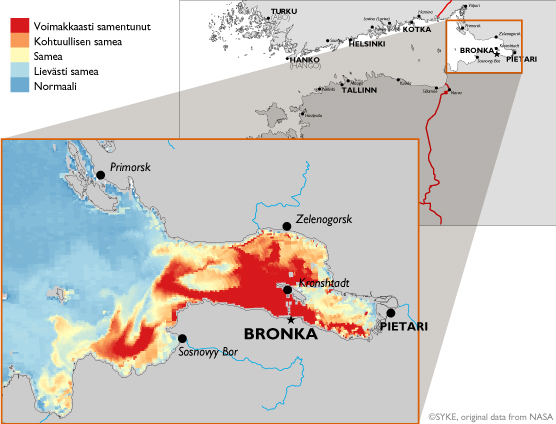Satellite images show that the dredging for the Port of Bronka located near St. Petersburg just inside a flood dam has caused increased turbidity in a wide area at the eastern end of the Gulf of Finland. According to the information provided by the satellite images and observation sampling stations by the eastern Finnish border, the clouded area does not extend to Finnish territorial waters. At its largest, the clouded area has spanned close to the Seskar island, which is about 50 km from the maritime boundary between Finland and Russia.

The map presents the location and extent of the clouded area. The areas where the satellite images indicated strong clouding are shown in red on the map. © Kuva: SYKE
Dredging volumes at Bronka are large: more than 15 million cubic metres in 2014 and 13 million cubic metres in 2015. The dredged sediment is estimated to consists largely of clay, i.e. fines that spread to a wide area causing turbidity. The clouding is diluted as it spreads, and the increased clay content of the water is likely to cause siltation near the dredging area. However, no abnormal turbidity readings have been observed at Finland’s easternmost water quality monitoring stations on the Huovari and Haapasaari islands in 2014 and 2015.
The analysis conducted by the State Research Institute of Lakes and Rivers Fishery of Russia indicates that the dredging has deteriorated the ecosystem to some extent by reducing the sustenance available to fish and destroying spawning areas, for example. According to the institute, these effects are local. The institute has been responsible for the hydrobiological monitoring of the port construction area since 2011.
More information is needed on harmful substances
In addition to the clouding and siltation effects, the dredging may result in the release and spreading of harmful substances in the water and cause eutrophication.
Harmful substances, such as heavy metals, may be released into water from the dredged material and the fines spread on a wide area. The harmful substances may have impacts even in small concentrations, and they can be enriched in the food web and travel far from their original source of emission. However, information on the quality, quantity and spreading of harmful substances nor the prior use of the dredged area is currently unavailable.
To assess the effects related to harmful substances, information neither on the quality and properties of the dredged material, as well as the disposal locations and methods, is required. The aim is to obtain this information from the Russian bodies that are responsible for the monitoring and control of the condition of the dredging area.
According to SYKE’s algae monitoring, the extensive blue-green algal blooms that appeared in the Gulf of Finland last summer were primarily caused by nutrients that flowed in from the Baltic Sea main basin and nutrients that were released from the Gulf of Finland’s own seabed under the poor oxygen conditions of 2014. The nutrients released from the seabed in connection to the Bronka dredging may have increased the extent of blooms in the easternmost part of the Gulf of Finland in August 2015.
SYKE is monitoring the possible effects of the Bronka dredging on turbidity and eutrophication by means of HELCOM’s open sea monitoring, coastal monitoring of the Centre for Economic Development, Transport and the Environment for Southeast Finland and remote sensing arrangements. As a result of the cooperation initiated within the framework of the Gulf of Finland Year 2014 project, information is also received from the North-West Administration for Hydrometeorology and Environmental Monitoring research institute, which is responsible for water quality monitoring in Russia.
The dredging for the first construction phase of the Port of Bronka are planned to be completed this year.
More information
Harri Kuosa, spread and biological effects of turbidity
Finnish Environment Institute
Tel. +358 295 251 106
firstname.lastname@ymparisto.fi
Jani Salminen, risks of dredging and disposal of the dredged material, harmful substances
Finnish Environment Institute
Tel. +358 295 251 608
firstname.lastname@ymparisto.fi